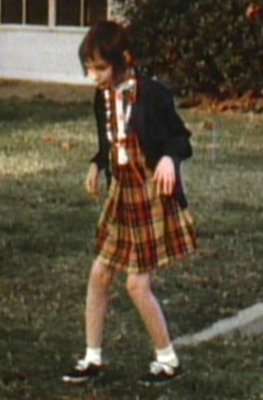Genie Wiley was the name given to a thirteen-year-old girl who had been a victim of severe abuse, neglect, and isolation since her birth. Her father, Clark Wiley, hated children and quickly tired of hearing baby Genie’s cries. As a result, at an early age, he threw her in the basement with nothing but a wire cage and a potty chair with a homemade strapping device. He believed Genie was mentally handicapped, and he used that excuse to keep Genie from both her family and from the outside world. He kept Genie either strapped to her potty chair or in a crib with her arms and legs immobilized. This left Genie severely malnourished. Her isolation made it impossible for her to acquire language during her childhood.1 Genie’s mother, Irene Wiley, who was almost blind from cataracts, and her older brother John Wiley, also suffered from the father’s abuse and lived in fear of him for years. But one day, Irene grew the courage to run off and tell a social worker about her husband’s dark secret. When the social worker found Genie, she was still wearing diapers and was unable to speak. Unable to face the truth of the damage he inflicted upon his family, Clark shot and killed himself. After thirteen years and seven months of unimaginable torture at the hands of her father, Genie was finally given the chance to learn how to live as an average human being. 2

In the first years after Genie’s liberation, psychologists, linguists, and other scientists became interested in Genie, seeing in her near-total isolation a unique chance to study many aspects of human development. The case was so scientifically important that the government funded a team of scientists to help answer the many questions that her conditions posed. James Kent, a child psychologist, and Susan Curtiss, a linguist, were the two scientists who became extremely close to Genie. Neither one of them had ever encountered a case as extreme as Genie’s. The scientists took advantage of the unheard of opportunity that Genie’s unique conditions provided them. Yet they also used Genie to address specific questions about “critical period theory” and the human mind. While many scientists researched Genie’s conditions, Susan Curtiss and James Kent had Genie stay with them in their own homes.3
The “critical period” theory states that there is a certain window of time when an adolescent can learn a language. The first few years of life is crucial for individuals to acquire their first language.4 If the learning of language occurs after this period of time, then the individual will never acquire the full command of a language. The evidence that supported the “critical period” theory was slim, which is why Genie was so important for proving or disproving the theory. According to the theory, Genie, who was now a teenager, had missed her time to learn words and grammatically put them into sentences. But the scientists wanted to try and see what repetitive teaching could accomplish. Susan Curtiss spent hours per week working with Genie to help her learn how to express herself in language.5

Susan Curtiss, a scientist from UCLA, worked with Genie in an attempt to improve her language skills. Genie seemed to have little to no control over any speech organs, and she showed defects in the muscles she used for chewing and swallowing. Susan Curtiss thought that if Genie was able to understand the English language spoken to her, then there was a good chance this would reflect some linguistic knowledge of the language, even though physical and psychological impediments prevented her from using this knowledge to produce speech. Unfortunately, Genie was unable to understand and respond to any form of commands, which meant that a controlled comprehension test would have to wait. Even though Genie scored at the level of a 1-year-old at her initial assessment, she quickly began adding new words to her vocabulary. Genie started by learning single words like “dog” and “run,” and then she began putting two words together, like “a dog house,” which is something young children can do.6 Curtiss began to feel that Genie would be fully capable of acquiring language. She had found that while Genie could use words, she could not produce grammar or even put together sentences. She could not arrange these words in a meaningful way. It started looking as though the “critical period” theory of language development might indeed be correct.7
James Kent, a child psychologist, stated that his first impression of Genie was incredibly surprising. Hers was the worst case of child abuse he had ever encountered, and he became extremely pessimistic about Genie’s prognosis. The restraints that Genie’s father used caused Genie’s wrists to develop extreme bruising, and her bones were unable to grow while she had been forced to sleep inside a crib. Kent found it extremely difficult to test Genie’s mental age, but the two times he did showed that Genie had the same mental ability as a thirteen-month old child.8 Despite tests confirming that she had normal vision in both eyes, she could not focus them on anything more than ten feet away. This was caused by being locked up inside a small room for thirteen years.9

Jay Shurly, a professor of psychiatry and behavioral sciences at the University of Oklahoma and a specialist in social isolation, took interest in Genie’s case. He started visiting Genie three days a week to conduct a sleep study to see if Genie was autistic, mentally challenged, or if she had sustained any bring damage during the time she was isolated. Shurly’s study concluded that Genie Wiley was not autistic but had high levels of emotional disturbance. Jay Shurly’s sleep study also showed a significantly reduced amount of REM sleep and a large number of sleep spindles. Shurly soon concluded that, based on the unusual amount of sleep spindles, Genie had been mentally retarded since birth. Some of the other scientists were not 100% sure if this information was true due to the substantial progress Genie was making in expressing herself. Much later, for example, Susan Curtiss argued that, even though Genie obviously had serious emotional issues, she could not have been retarded. She pointed out that Genie made a year’s developmental progress for every calendar year after her rescue, which would not be expected if her condition was congenital, and that some aspects of language that Genie acquired were uncharacteristic of mentally retarded individuals.10
>On account of many people fighting over Genie to do their research, Genie was forced to move back in with her biological mother in 1975. Genie’s mother attempted to sue the children hospital and many other scientists for treating her daughter more like a test dummy than a human being. All scientists were shut off from Genie. This caused Genie’s conditions to get worse and her mother found her too difficult to take care of and sent her back into a foster home, where Genie was subject to further abuse. After scientists were no longer allowed to use Genie as a test subject, more questions arose.11 Did research interfere with Genie’s therapeutic treatment? Unfortunately, after leaving Genie alone in foster care, her progress was compromised and she was afraid to open her mouth, which led her back to silence.12
- Encyclopedia of Special Education: A Reference for the Education of Children, Adolescents, and Adults with Disabilities and Other Exceptional Individuals, 2013, s.v. “Kasper Hauser Syndrome,” by Cecil R. Reynolds, Kimberly J. Vannest, and Elaine Fletcher-Janzen. ↵
- Kendra Cherry, “Overview of feral child Genie Wiley,” Very well Mind, November 25, 2018, https://www.verywellmind.com/genie-the-story-of-the-wild-child-2795241. ↵
- Loretta Kasper, “The Civilizing of Genie,” In Teaching English through the Disciplines: Psychology, October 8, 2002, http://kccesl.tripod.com/genie.html. ↵
- Dictionary of Linguistics and Phonetics, 2008, s.v. “Critical period,” by David Crystal; Salem Press Encyclopedia, 2018, s.v. “Critical Period Hypothesis,” by Janine Ungvarsky. ↵
- Loretta Kasper, “The Civilizing of Genie,” In Teaching English through the Disciplines: Psychology, October 8, 2002, http://kccesl.tripod.com/genie.html. ↵
- Dictionary of Sociolinguistics, 2004, s.v. “Zone of proximal development (ZPD),” by Joan Swann, Ana Deumert, Theresa Lillis. ↵
- Loretta Kasper, “The Civilizing of Genie,” In Teaching English through the Disciplines: Psychology, October 8, 2002, http://kccesl.tripod.com/genie.html. ↵
- Encyclopedia of Special Education: A Reference for the Education of Children, Adolescents, and Adults with Disabilities and Other Exceptional Individuals, 2013, s.v. “Genie,” by Cecil R. Reynolds, Kimberly J. Vannest, and Elaine Fletcher-Janzen. ↵
- Encyclopedia of Special Education: A Reference for the Education of Children, Adolescents, and Adults with Disabilities and Other Exceptional Individuals, 2013, s.v. “Kasper Hauser Syndrome,” by Cecil R. Reynolds, Kimberly J. Vannest, and Elaine Fletcher-Janzen. ↵
- Roger Shattuck, The Forbidden Experiment (New York: Farrar Straus Giroux, 1980), 216-218; Kendra Cherry, “Overview of feral child Genie Wiley,” Very well Mind, November 25, 2018, https://www.verywellmind.com/genie-the-story-of-the-wild-child-2795241. ↵
- Kendra Cherry, “Overview of feral child Genie Wiley,” Very well Mind, November 25, 2018, https://www.verywellmind.com/genie-the-story-of-the-wild-child-2795241. ↵
- Encyclopedia of Special Education: A Reference for the Education of Children, Adolescents, and Adults with Disabilities and Other Exceptional Individuals, 2013, s.v. “Feral Children,” by Cecil R. Reynolds, Kimberly J. Vannest, and Elaine Fletcher-Janzen. ↵



109 comments
Nicole Ortiz
I had no idea that this “Critical Period” theory even existed and so it was really interesting to learn about it. Overall, this article came to me as a shock because i just don’t understand why people have children or decide to keep them if they don’t really want to take care of them and love them when they could be living with a family that does love them. Through Genie’s abuse that she experienced, she was stripped away from any and all contact from the outside world and was treated like as if she didn’t exist. The part that surprised me the most was the fact that even though she was 13 years old, due to her lack of human interaction and contact, she had the mentality of a 1 year old baby. I personally think that it was wrong of the mother to take her back and continue to neglect her and eventually give her away to the foster system because although those scientists were conducting research on her, they were doing it as a way to try and help her and understand what it was she was going through. But due to her mother cutting off any contact with them, instead of trying to help and provide a life for Genie, it caused her to return to her feral and baby-like state, taking away any chance of her ever potentially becoming a “normal” person.
D'Hannah Duran
Prior to this article I was unaware of the “critical period theory” which does seem like something that would be important a person’s development. To think that Genie was ripped of that pivotal time of her life due to an abusive father is sad, if she had just been given the opportunity to be able to learn or live then she wouldn’t have had to undergo all of the testing.
Zoe Peña
I’ve heard the story of Genie Wiley in a previous class and was intrigued to find this article here. You did a good job of writing about the abuse she went through and how her experience led to scientists having more evidence on the “critical period” of life. As someone with a love for science I can understand why many would want to test her developmental abilities, but at the same time, like you said, she’s not just a test dummy but instead a human being.
Skylar De Leon
This article is what introduced me to the “Critical Period” theory, as I had never heard of it before now. It’s interesting how little people knew about it and how so many people jumped at the chance to study it, seeming to almost forget that it was a human being that they were studying. It’s weird to think how while it seemed that scientists were treating her more of a test subject than a person, they probably could have made more progress that way instead of leaving her in isolation.
Ariana Brown
Wow. This is an incredibly disturbing article. I’m surprised a social worker did not step in when the mother regained custody of Genie. Genie’s mother was present during the father’s abuse and did nothing to help Genie during this time. It can be argued that this is due to the abuse she received from Genie’s father but she could have tried to help Genie develop as much as possible in the condition the father put her in. A social worker should have also stepped in when Genie’s mother did not want to keep her anymore. I wonder if the scientists could have done anything after the fact to help her develop.
Audrey Uribe
I was unaware of the “critical period theory” until reading this article. It was so sad to read about the traumatic environment and events that Genie Wiley lived through from such a young age. Its unimaginable to me how a parent could neglect a child into becoming “feral”. It is interesting that the scientist found she could express herself which only means she was comprehending some sort of intelligence but with her REM sleep patterns having affected her sleep spindles, she was inconclusive to the scientists test. Sad to read that she was then again neglected and was unable to keep connection with her therapeutic treatment and scientist and lost her speech.
Olivia Tijerina
The article’s main focus was towards the life of a rescued girl named Genie; a story that was approached in different kinds of sciences in human development. Because Genie was retained from such development her challenges outweighed the growth, especially in research, because she had remained under the influence of the life she had begun in. The article does well in the description from Genie’s life to be able to apply to a temporary impact in science.
Cristianna Tovar
I had read a part of Genie’s story in my sociology textbook, so when I came across this article, I knew I had to read it. This article depicts the horrible and tortuous environment that Genie was forced in to since birth. To me, what’s even worse is that she was taken away from the people who were trying to help her grow verbally and develop mentally. As stated in the article, the separation from those who were helping Genie drove her to not speak at all anymore. My heart breaks for her, and I hope she’s making at least a little bit of progress. If there was anything I would suggest to be added to the article, it would be an update to where she is and how she is doing today.
Sabrina Doyon
This story made me so sad! This poor little girl was never given a childhood and even when she was saved, she was treated like a wild animal. It is so depressing that she was making progress and then she was just thrown away. I can’t believe the terrible treatment this poor little girl had. I sincerely hope that this isn’t the end of her story. This article was so emotional and I honestly almost cried. I hope that treatments and care for neglected children has improved.
Isabella Torres
This is one of the most gut wrenching and disheartening stories I have read in a while. It is so difficult to even try to comprehend how life would be locked up in the same room for 13 years of your life, not to mention the constant abuse. It’s even crazier to me how Genie ended up being left all alone in the foster care system, back to being abused. It’s hard to believe how she wasn’t found sooner or that her mother waited such a long time to get help. This article makes me wonder if Genie would have eventually reached fluency in english and been able to live out her life if she would have been able to continue therapy. Such a heartbreaking story.
Kristina Tijerina
This is such a heart wrenching article. The fact that this child’s own father abused her so horribly she had permanent bruising, wasn’t able to speak, and her bones weren’t able to grow anymore is so cruel. I understand that the mother was very scared of the situation she was in, but I think saving your child should be first priority. I’m glad the mother eventually grew the courage, but if she could have gotten Genie out of the father’s grasp sooner she might have had a better life. Not to mention the fact that the mother tried suing the children hospital Genie was at. She’s right, Genie was probably getting treated as a test subject, however she was still getting better and improving. I think for the mother to try and sue the hospital only to throw her child back into foster care where abuse continued is extremely unfair. Genie was stripped of getting a fair shot at life for being a child. How terrible.